2023年英语中考名词及主谓一致课件(22张PPT)
文档属性
| 名称 | 2023年英语中考名词及主谓一致课件(22张PPT) | 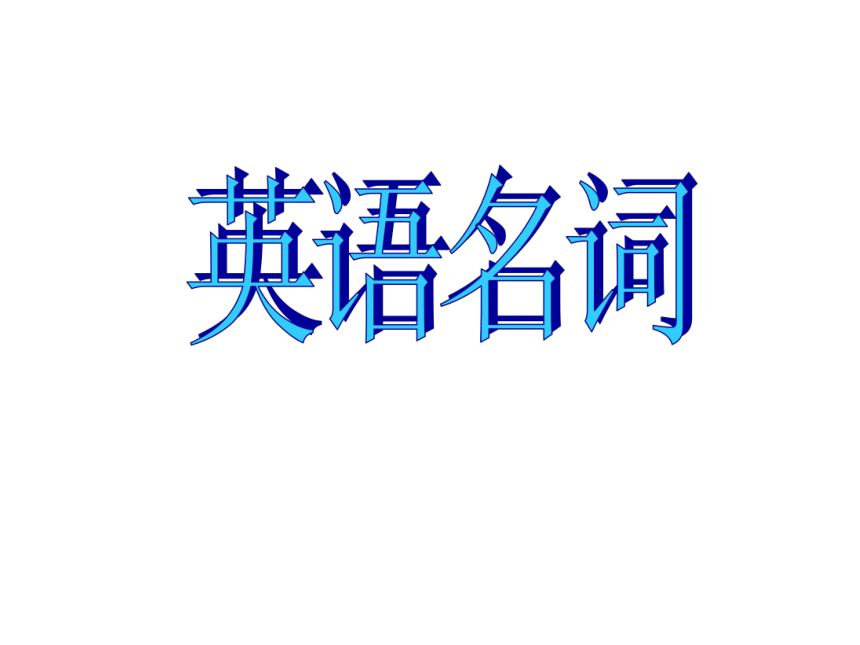 | |
| 格式 | pptx | ||
| 文件大小 | 7.3MB | ||
| 资源类型 | 教案 | ||
| 版本资源 | 通用版 | ||
| 科目 | 英语 | ||
| 更新时间 | 2023-08-08 20:02:12 | ||
图片预览

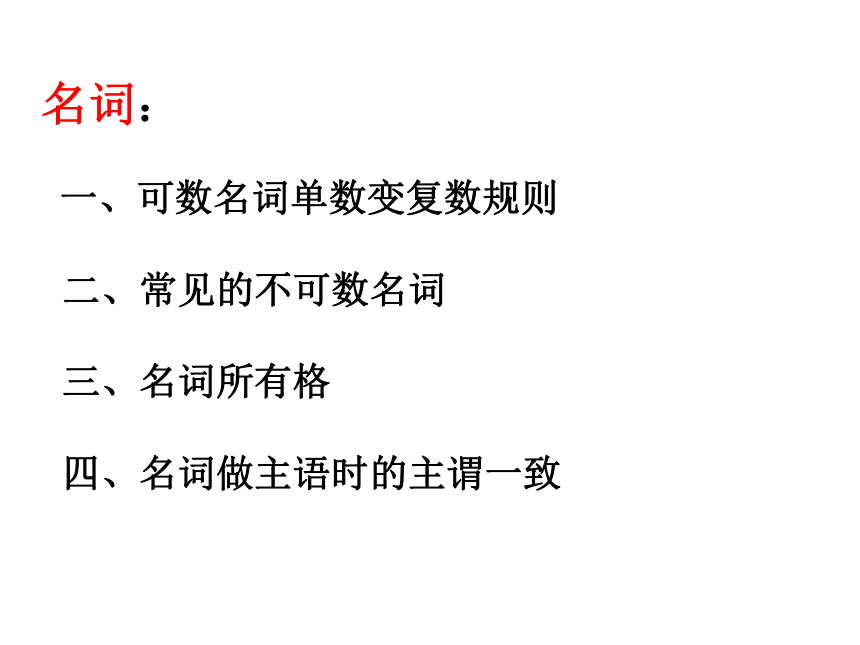
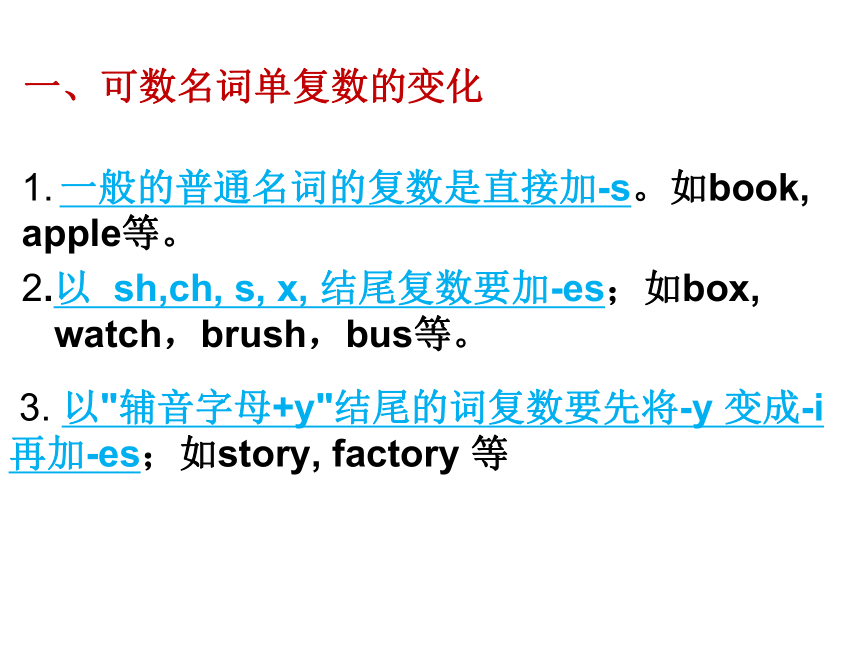
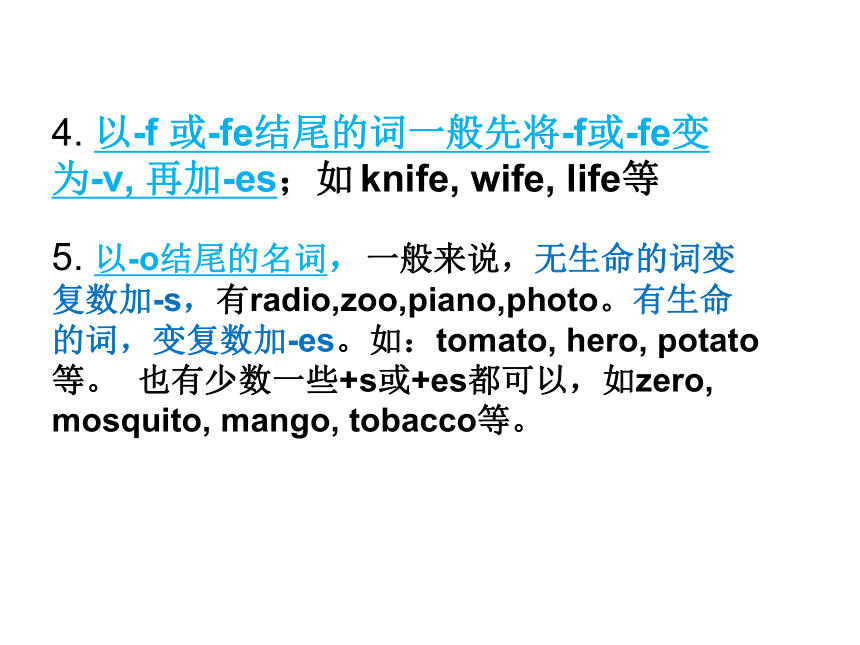
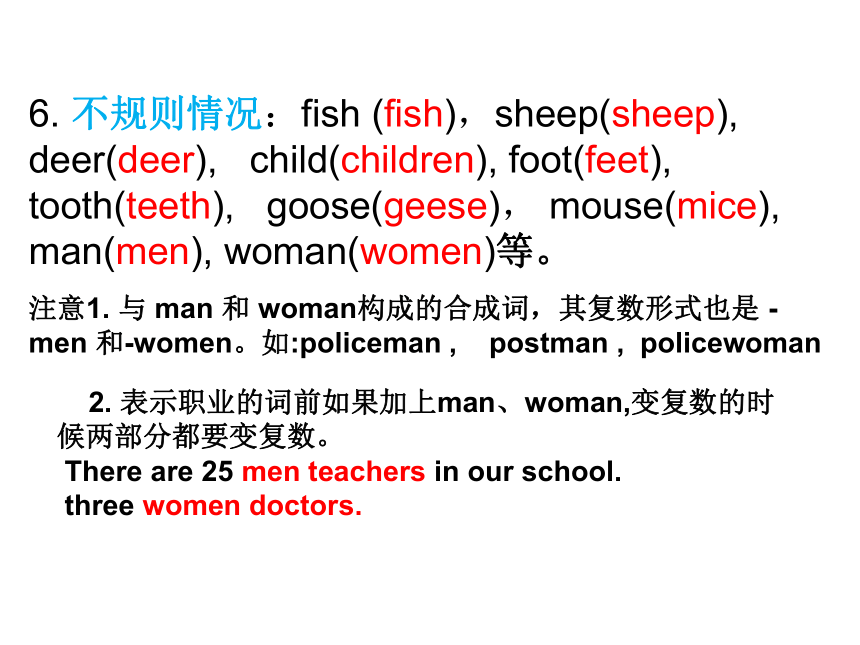
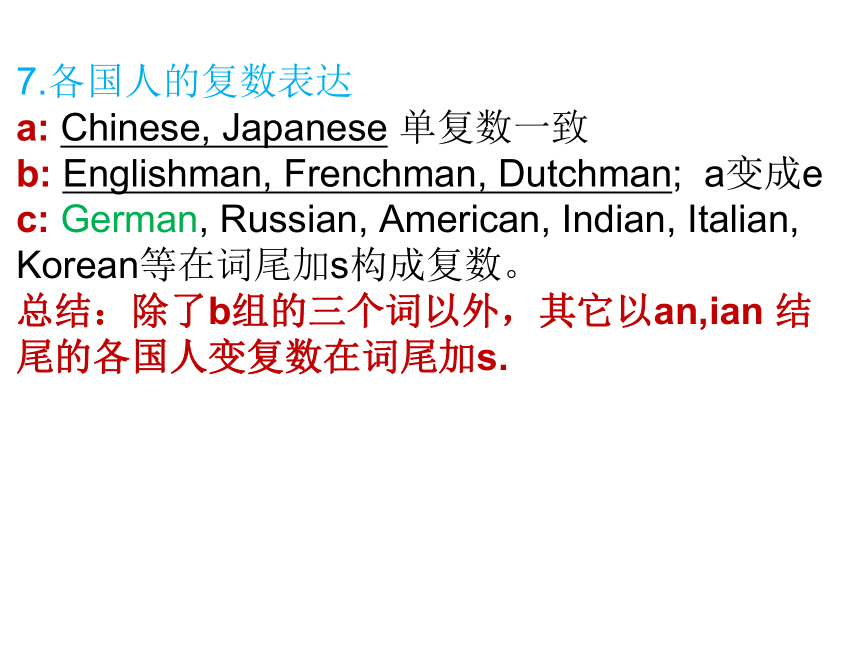
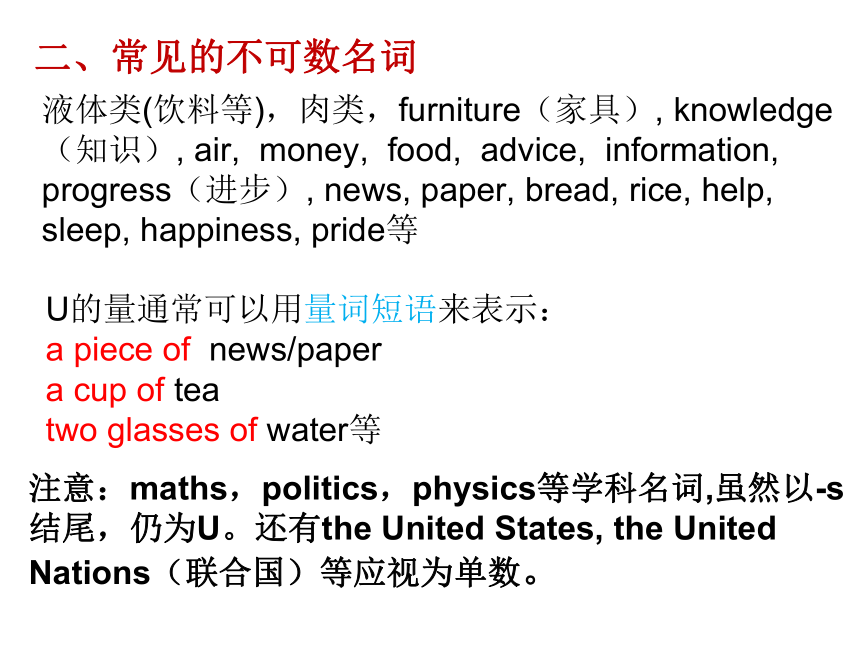
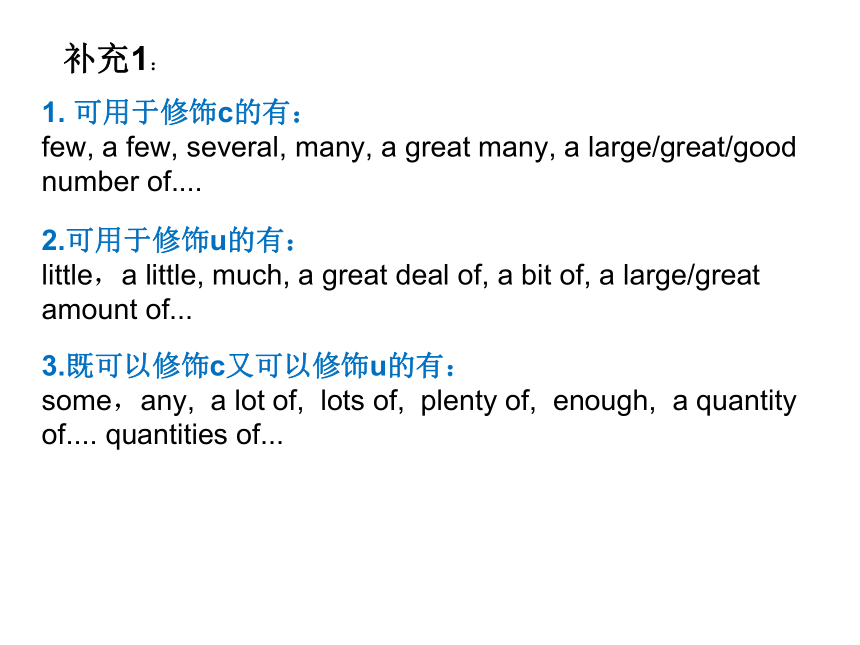
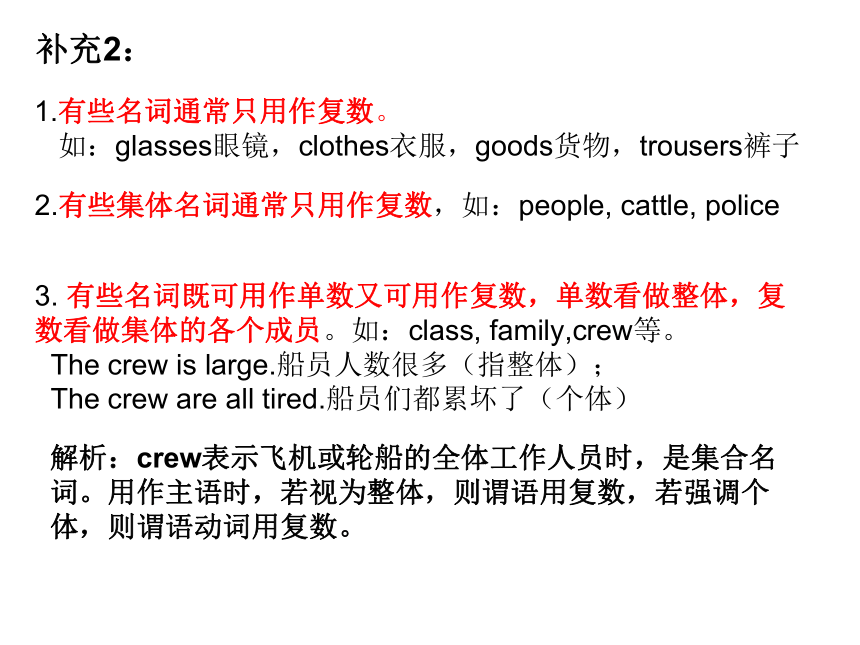
文档简介
(共22张PPT)
英语名词
名词:
一、可数名词单数变复数规则
二、常见的不可数名词
三、名词所有格
四、名词做主语时的主谓一致
一、可数名词单复数的变化
1. 一般的普通名词的复数是直接加-s。如book, apple等。
2.以 sh,ch, s, x, 结尾复数要加-es;如box, watch,brush,bus等。
3. 以"辅音字母+y"结尾的词复数要先将-y 变成-i再加-es;如story, factory 等
4. 以-f 或-fe结尾的词一般先将-f或-fe变为-v, 再加-es;如 knife, wife, life等
5. 以-o结尾的名词,一般来说,无生命的词变复数加-s,有radio,zoo,piano,photo。有生命的词,变复数加-es。如:tomato, hero, potato等。 也有少数一些+s或+es都可以,如zero, mosquito, mango, tobacco等。
6. 不规则情况:fish (fish),sheep(sheep), deer(deer), child(children), foot(feet), tooth(teeth), goose(geese), mouse(mice), man(men), woman(women)等。
注意1. 与 man 和 woman构成的合成词,其复数形式也是 -men 和-women。如:policeman , postman , policewoman
2. 表示职业的词前如果加上man、woman,变复数的时候两部分都要变复数。
There are 25 men teachers in our school.
three women doctors.
7.各国人的复数表达
a: Chinese, Japanese 单复数一致
b: Englishman, Frenchman, Dutchman; a变成e
c: German, Russian, American, Indian, Italian, Korean等在词尾加s构成复数。
总结:除了b组的三个词以外,其它以an,ian 结尾的各国人变复数在词尾加s.
二、常见的不可数名词
注意:maths,politics,physics等学科名词,虽然以-s结尾,仍为U。还有the United States, the United Nations(联合国)等应视为单数。
U的量通常可以用量词短语来表示:
a piece of news/paper
a cup of tea
two glasses of water等
液体类(饮料等),肉类,furniture(家具), knowledge(知识), air, money, food, advice, information, progress(进步), news, paper, bread, rice, help, sleep, happiness, pride等
补充1:
1. 可用于修饰c的有:
few, a few, several, many, a great many, a large/great/good number of....
2.可用于修饰u的有:
little,a little, much, a great deal of, a bit of, a large/great amount of...
3.既可以修饰c又可以修饰u的有:
some,any, a lot of, lots of, plenty of, enough, a quantity of.... quantities of...
补充2:
1.有些名词通常只用作复数。
如:glasses眼镜,clothes衣服,goods货物,trousers裤子
2.有些集体名词通常只用作复数,如:people, cattle, police
3. 有些名词既可用作单数又可用作复数,单数看做整体,复数看做集体的各个成员。如:class, family,crew等。
The crew is large.船员人数很多(指整体);
The crew are all tired.船员们都累坏了(个体)
解析:crew表示飞机或轮船的全体工作人员时,是集合名词。用作主语时,若视为整体,则谓语用复数,若强调个体,则谓语动词用复数。
三、名词所有格: 表示“……的”
2.无生命名词的所属要用介词of来帮助一下,如:a map of China,the end of this term,
The legs of this table
1.通常是在名词的后面加’s,如:Children’s day,father’s shoes, Tom’s bike
3.双重所有格:当有生命的所有格中的所属物前面有了数量词来限定时,一般用双重所有格,
即:of+n.’s (of 前面的词有a/an, 数词,any, some, several, few, another或this, that, those, these等词修饰时常用双重所有格)
例句:
He is another friend of my father's.
Mr.Wang is a teacher of my brother's.
some friends of Tom's
★ 补充:双重所有格的另外一种结构-- “of+名词性物主代词”
They are some friends of mine.
a good habit of his.
1. 以s结尾的复数名词,只在词尾加’
the students’ books, the girls’ toys
所有格的构成:
2. 不以s结尾的复数名词,加’s
Children’s day, women’s club
3.以s结尾的词,但不是复数n,可加’s 也可只加’
Tomas’(s) book, my boss’(s) car
4.如果一样东西为两人共有,则只在最后一个n后加’s构成所有格,如果是分别所拥有的,要在每个n后面都加’s。
如:John and Mary's room
John’s and Mary’s rooms
5. 表示某人的诊所,家,店铺等的所有格后的n往往省略。
如:at the doctor’s, at the barber’s,
at my mother’s
名词所有格需要注意的地方:
This is a photo of my father.
这是我父亲的照片(照片上的人是我父亲)
This is a photo of my father’s
这是我父亲的照片(照片属于我父亲,照片上的人不一定是我父亲)
四、n做主语时的主谓一致
1.句子的主语为c单数或u时,谓语v.用单数。
The boy likes apples. Steak tastes good.
2.句子的主语时复数n时,谓语v.用复数,即原形
The students are learning English now.
3. 主语为单数,但后面有with, together with, as well as, but等连接另外的名词时,谓语v.由第一个名词决定,用单数,即就远原则。
Tom, with his friends is playing football.
Tom as well as Jim likes playing basketball.
4.由and, both…and…等连接的并列主语,谓语v.通常用复数,但当用and 连接的两个n.指同一事物或往往作为一体使用时,谓语v.则一般用单数。
Mary and I are good friends.
Both Lucy and Mary study in this school.
Air and water are important for humans.
The knife and fork is here.
Bread and butter is my favorite breakfast.
5. 由连词either…or…, neither…nor…, not only…but also…等连接的并列主语,谓语v.与最近的主语保持一致,即就近原则。
Neither you nor I am a student.
Either Sam or Jack is from England.
Not only you but also I am tired.
6. 在There be 句型中也遵循就近原则。
There is an apple and two bananas on the table.
There are two bananas and an apple on the table.
7.The+姓氏的复数常表示××一家人,谓语动词用复数。
The Smiths are going to see a movie this weekend.
The Blacks are from America.
1. The farmer raised ten _________.
A. sheeps B. deers C. horse D. cows
2.Tom, together with his friends usually_____
Shopping on weekends.
go B. went C. goes D. going
3. Not only Jim but also his friends _____ swimming.
A. likes B. like C. liked D. goes
D
c
B
4. Li Ping met an old friend of _______on a train
yesterday.
A. he B. him C. his D. her
5. _________are big and bright.
A. The classroom window
B. The window of the classroom
C. The windows of the classroom
D. The classroom's windows
6.Your wife as well as you _____ (be) friendly to me.
7. Neither you nor Jim _____ a teacher.
A. is B. are C. be D. am
C
C
is
A
Thank you!!
英语名词
名词:
一、可数名词单数变复数规则
二、常见的不可数名词
三、名词所有格
四、名词做主语时的主谓一致
一、可数名词单复数的变化
1. 一般的普通名词的复数是直接加-s。如book, apple等。
2.以 sh,ch, s, x, 结尾复数要加-es;如box, watch,brush,bus等。
3. 以"辅音字母+y"结尾的词复数要先将-y 变成-i再加-es;如story, factory 等
4. 以-f 或-fe结尾的词一般先将-f或-fe变为-v, 再加-es;如 knife, wife, life等
5. 以-o结尾的名词,一般来说,无生命的词变复数加-s,有radio,zoo,piano,photo。有生命的词,变复数加-es。如:tomato, hero, potato等。 也有少数一些+s或+es都可以,如zero, mosquito, mango, tobacco等。
6. 不规则情况:fish (fish),sheep(sheep), deer(deer), child(children), foot(feet), tooth(teeth), goose(geese), mouse(mice), man(men), woman(women)等。
注意1. 与 man 和 woman构成的合成词,其复数形式也是 -men 和-women。如:policeman , postman , policewoman
2. 表示职业的词前如果加上man、woman,变复数的时候两部分都要变复数。
There are 25 men teachers in our school.
three women doctors.
7.各国人的复数表达
a: Chinese, Japanese 单复数一致
b: Englishman, Frenchman, Dutchman; a变成e
c: German, Russian, American, Indian, Italian, Korean等在词尾加s构成复数。
总结:除了b组的三个词以外,其它以an,ian 结尾的各国人变复数在词尾加s.
二、常见的不可数名词
注意:maths,politics,physics等学科名词,虽然以-s结尾,仍为U。还有the United States, the United Nations(联合国)等应视为单数。
U的量通常可以用量词短语来表示:
a piece of news/paper
a cup of tea
two glasses of water等
液体类(饮料等),肉类,furniture(家具), knowledge(知识), air, money, food, advice, information, progress(进步), news, paper, bread, rice, help, sleep, happiness, pride等
补充1:
1. 可用于修饰c的有:
few, a few, several, many, a great many, a large/great/good number of....
2.可用于修饰u的有:
little,a little, much, a great deal of, a bit of, a large/great amount of...
3.既可以修饰c又可以修饰u的有:
some,any, a lot of, lots of, plenty of, enough, a quantity of.... quantities of...
补充2:
1.有些名词通常只用作复数。
如:glasses眼镜,clothes衣服,goods货物,trousers裤子
2.有些集体名词通常只用作复数,如:people, cattle, police
3. 有些名词既可用作单数又可用作复数,单数看做整体,复数看做集体的各个成员。如:class, family,crew等。
The crew is large.船员人数很多(指整体);
The crew are all tired.船员们都累坏了(个体)
解析:crew表示飞机或轮船的全体工作人员时,是集合名词。用作主语时,若视为整体,则谓语用复数,若强调个体,则谓语动词用复数。
三、名词所有格: 表示“……的”
2.无生命名词的所属要用介词of来帮助一下,如:a map of China,the end of this term,
The legs of this table
1.通常是在名词的后面加’s,如:Children’s day,father’s shoes, Tom’s bike
3.双重所有格:当有生命的所有格中的所属物前面有了数量词来限定时,一般用双重所有格,
即:of+n.’s (of 前面的词有a/an, 数词,any, some, several, few, another或this, that, those, these等词修饰时常用双重所有格)
例句:
He is another friend of my father's.
Mr.Wang is a teacher of my brother's.
some friends of Tom's
★ 补充:双重所有格的另外一种结构-- “of+名词性物主代词”
They are some friends of mine.
a good habit of his.
1. 以s结尾的复数名词,只在词尾加’
the students’ books, the girls’ toys
所有格的构成:
2. 不以s结尾的复数名词,加’s
Children’s day, women’s club
3.以s结尾的词,但不是复数n,可加’s 也可只加’
Tomas’(s) book, my boss’(s) car
4.如果一样东西为两人共有,则只在最后一个n后加’s构成所有格,如果是分别所拥有的,要在每个n后面都加’s。
如:John and Mary's room
John’s and Mary’s rooms
5. 表示某人的诊所,家,店铺等的所有格后的n往往省略。
如:at the doctor’s, at the barber’s,
at my mother’s
名词所有格需要注意的地方:
This is a photo of my father.
这是我父亲的照片(照片上的人是我父亲)
This is a photo of my father’s
这是我父亲的照片(照片属于我父亲,照片上的人不一定是我父亲)
四、n做主语时的主谓一致
1.句子的主语为c单数或u时,谓语v.用单数。
The boy likes apples. Steak tastes good.
2.句子的主语时复数n时,谓语v.用复数,即原形
The students are learning English now.
3. 主语为单数,但后面有with, together with, as well as, but等连接另外的名词时,谓语v.由第一个名词决定,用单数,即就远原则。
Tom, with his friends is playing football.
Tom as well as Jim likes playing basketball.
4.由and, both…and…等连接的并列主语,谓语v.通常用复数,但当用and 连接的两个n.指同一事物或往往作为一体使用时,谓语v.则一般用单数。
Mary and I are good friends.
Both Lucy and Mary study in this school.
Air and water are important for humans.
The knife and fork is here.
Bread and butter is my favorite breakfast.
5. 由连词either…or…, neither…nor…, not only…but also…等连接的并列主语,谓语v.与最近的主语保持一致,即就近原则。
Neither you nor I am a student.
Either Sam or Jack is from England.
Not only you but also I am tired.
6. 在There be 句型中也遵循就近原则。
There is an apple and two bananas on the table.
There are two bananas and an apple on the table.
7.The+姓氏的复数常表示××一家人,谓语动词用复数。
The Smiths are going to see a movie this weekend.
The Blacks are from America.
1. The farmer raised ten _________.
A. sheeps B. deers C. horse D. cows
2.Tom, together with his friends usually_____
Shopping on weekends.
go B. went C. goes D. going
3. Not only Jim but also his friends _____ swimming.
A. likes B. like C. liked D. goes
D
c
B
4. Li Ping met an old friend of _______on a train
yesterday.
A. he B. him C. his D. her
5. _________are big and bright.
A. The classroom window
B. The window of the classroom
C. The windows of the classroom
D. The classroom's windows
6.Your wife as well as you _____ (be) friendly to me.
7. Neither you nor Jim _____ a teacher.
A. is B. are C. be D. am
C
C
is
A
Thank you!!
同课章节目录
- 词法
- 名词
- 动词和动词短语
- 动词语态
- 动词时态
- 助动词和情态动词
- 非谓语动词
- 冠词
- 代词
- 数词和量词
- 形容词副词及其比较等级
- 介词和介词短语
- 连词和感叹词
- 构词法
- 相似、相近词比较
- 句法
- 陈述句
- 一般疑问句和否定疑问句
- 特殊疑问句及选择疑问句
- 反意疑问句
- 存在句(There be句型)
- 宾语从句
- 定语从句
- 状语从句
- 主谓一致问题
- 简单句
- 并列句
- 复合句
- 主谓一致
- 主、表语从句
- 名词性从句
- 直接引语和间接引语
- 虚拟语气
- 感叹句
- 强调句
- 倒装句
- 祈使句
- 句子的成分
- 句子的分类
- 题型专区
- 单项选择部分
- 易错题
- 完形填空
- 阅读理解
- 词汇练习
- 听说训练
- 句型转换
- 补全对话
- 短文改错
- 翻译
- 书面表达
- 任务型阅读
- 语法填空
- 其他资料
